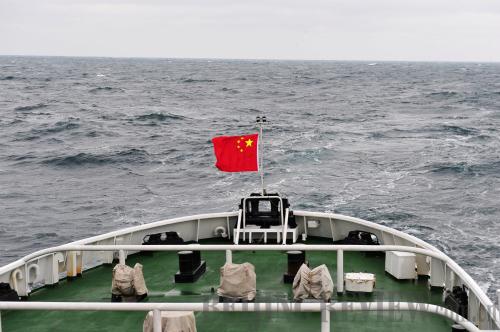|
 |
|
REGULAR PATROLLING: A Chinese marine surveillance ship continues its regular patrol in the territorial waters surrounding the Diaoyu Islands on the eve of the traditional Spring Festival on February 9 (ZHANG JIANSONG) |

The Japanese government ultimately decided against publishing the so-called "related evidence" collected by the Japanese Self-Defense Forces regarding Chinese ships using fire control radar (FCR) against its warships. A Chinese proverb says that he who makes the initial offense always files the suit first—which may also describe the fuss recently made by Japan. However, Japan's attempt to hype the FCR incident also brings to the forefront issues that should be considered.
First, the incident reflects that some Japanese military and political officials lack in basic military knowledge. Japanese Defense Minister Itsunori Onodera claimed that a Chinese frigate directed an FCR onto a Japanese fleet at a distance of 3 km in the open waters of the East China Sea on January 30. But what does "3 km" really mean? It is obviously the distance perceivable to the naked eye; therefore, the radar probably was not required to give instructions for the ship-borne gun to shoot the target. Even if it is assumed that the radar was used to give the guided missile instructions about the target, a little military common sense would make clear that 3 km fall into the blind zone of the guided missile's firing range. At such a close distance, the guided missile cannot effectively find the target even with the use of the FCR, nullifying any supposed threat. Japan's claim only makes a laughing stock of itself.
Second, it would have been a dereliction of duty if Chinese warships were not being alert and sent a warning while Japanese military aircraft and warships were approaching so close to confrontation. It is illogical that Chinese warships would merely stay there like a sitting duck watching Japanese military aircraft and warships conducting close-in monitoring and surveillance near the fleet. If Chinese warships didn't initiate search and surveillance radar, they would be at risk of attack and destruction. Japan had previously threatened to launch warning shots at Chinese warships, and it would then be very possible that they might launch live ammunition or warning shells at the Chinese fleet. It is natural that Chinese warships should act to defend themselves.
Moreover, it should be asked which side bears responsibility if a military conflict did occur. The answer is that the responsibility would lie entirely on the Japanese side. Since the Chinese fleet was conducting normal training in international open waters, Japan initiated close-in monitoring and surveillance on and interference with the normal navigation of the Chinese fleet, which is illegal and groundless. Such interference has occurred repeatedly. Incomplete statistics show that every year, 500-plus Japanese aircraft conduct close-in monitoring and surveillance on Chinese fleets. It is also common for Japanese warships to stalk and interfere with the navigation of Chinese fleets. Such behavior would be considered military provocations by any country in the world. In addition, Japanese military aircraft also engage in reckless behavior at sea to provoke Chinese airplanes from time to time. For instance, a Japanese F-15J fighter recently flew by the wing of a Chinese Y-8 patrol airplane only 5 meters away. The smallest error might have resulted in the crash of the aircraft and the death of the pilots.
It is ridiculous for Japan to be allowed to make provocations while China is forbidden to defend itself. Japan should acknowledge that if its military force poses a threat to Chinese fleets, Chinese fleets will undoubtedly carry out warnings and expelling moves at an appropriate distance (not within the 3-km dead angle and blind zone as claimed by Japan). If Japan ignores the prudent advice of China, then the use of FCR should not be out of the question in the future. If Japan obstinately makes any dangerous moves, China will resolutely defend itself without compromise.
Japan should not be given the final say unilaterally on the rules of the game in the East China Sea. It should know that setting up an air defense identification zone is not its exclusive privilege, nor is the firing of warning shots. China also has the right to take the same precautions.
To keep the peace in the East China Sea and safeguard its legitimate rights, China should establish clear rules for Japan in the area.
The author is a military expert and Executive Vice President of the China Strategy and Culture Promotion Association
Email us at: yanwei@bjreview.com | 